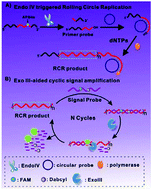Endonuclease IV cleaves apurinic/apyrimidinic sites in single-stranded DNA and its application for biosensing†
Abstract
Endonuclease IV (Endo IV), as a DNA repairing enzyme, plays a crucial role in repairing damaged DNA comprising abasic sites to maintain genomic integrity. The cleaving capability of Endo IV to apurinic/apyrimidinic sites (AP) in single-stranded DNA (ssDNA) was demonstrated. It was found that Endo IV has considerably high cleaving activity to AP sites in ssDNA compared with that in double-stranded DNA (dsDNA). The unique feature of Endo IV in cleaving AP sites in ssDNA was further applied to construct a novel dual signal amplified sensing system for highly sensitive enzyme and protein detection by a combination of exonuclease III (Exo III)-aided cyclic amplification reaction and a rolling circle replication (RCR) technique, which showed a good sensing performance with a detection limit of 0.008 U mL−1 for Endo IV and 2.5 pM for streptavidin. In addition, the developed method had considerably high specificity for Endo IV and streptavidin over other potential interferences. The developed strategy indeed provides a novel platform for protein and enzyme assays and may find a broad spectrum of applications in bioanalysis, disease diagnosis, and drug development.


 Please wait while we load your content...
Please wait while we load your content...